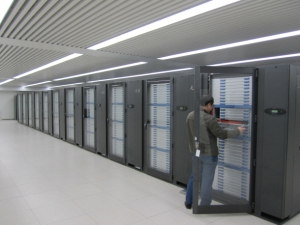China aims for exascale computer within 10 years

China plans to create an exascale supercomputer by 2020 and to develop technologies for it that will wean the country off chips from Western companies such as Intel and Nvidia.

China aims to build on the success of its Tianhe-1A supercomputer (pictured) by creating an exascale supercomputer by 2020. Photo credit: Nvidia
The move launches China into the race to be the first country to house an exascale high-performance computer (HPC). Europe has plans to develop an exascale supercomputer by 2019 via the Partnership for Advanced Computing in Europe (Prace) scheme, while US chip giant Intel has disclosed plans to build an exascale machine by 2018, in collaboration with SGI.
"China is preparing to work on a supercomputer with a capacity of 100 petaflops by 2015 and try to produce the first exascale computer in 2020," said Hu Qinqfeng, deputy chief designer of China's fastest supercomputer, the Tianhe-1A, quoted in a report in China Daily on Saturday.
An exaflop is equivalent to a thousand trillion calculations per second, which is roughly 1,000 times faster than the petaflops achieved by the world's brace of leading supercomputers. It is likely that exaflop computers will be used to carry out weather simulations, protein folding and analysis of geological data for the oil and gas industry.
Work on the Chinese computer will be led by the National University of Defence Technology (NUDT), which designed the Tianhe-1A, now the world's second-fastest computer, according to the Linpack benchmark reported in the Top500 ranking. The Tianhe-1A is capable of 2.57 petaflops of peak computation, whereas the Top500 leader, the Fujitsu-designed Japanese K Computer, has reached 8.16 petaflops.
China's ambitions
China's HPC ambitions have been noted by leading companies and the US government. In September, 2010, an IBM executive said the scale of investment China and other emerging countries were devoting to their supercomputing efforts meant they would "eat [the West's] collective lunch".
Between October 2010 and June 2011, the Tianhe-1A was the world's most powerful supercomputer, according to the Top500 list. This disquieted the US Department of Energy's (DOE) undersecretary, Steven Koonin, who picked out China's aggressive technology development as a cause for concern.
Tianhe-1A's ascendance "reinforces the need to act decisively and promptly to develop the next generation of US supercomputers while harnessing existing computing power to drive innovation in science, industry, and national security", Koonin wrote in a blog post on 29 October, 2010.
"While the Chinese Tianhe-1A machine has been built using US-designed processors and memory, it uses Chinese-designed interconnects that are faster than those used in US supercomputers," Koonin wrote. "The Chinese have also become skilled in processor design and fabrication and are building another petaflop-class supercomputer using entirely indigenous components that is expected to be complete within the next 12 to 18 months.
"It is clear that DOE will not be the only organisation working to push the limits of computer performance," he said.
Reducing reliance on Western technology
To support the exascale project, Chinese researchers have been working on alternatives to Western technologies, to help cut their reliance on chips made by US-based companies such as Nvidia and Intel.
The Tianhe-1A contained 2,048 Chinese-designed NUDT FT1000 heterogeneous processors along with a Chinese-designed interconnect. However, the brunt of its processing power came from 14,336 Intel Xeon X5670 CPUs and 7,168 Nvidia Tesla M2050 GPUs.
"The next target for the Tianhe-1A team is to build a machine that can perform tens of petaflops per second, as well as developing new CPUs and graphics processing units (GPUs)," the China Daily reported.
To that end, China has announced plans to use Chinese-developed Loongson chips as the mainstay processors for its Dawning 6000 supercomputer. The Dawning 6000 has the somewhat humble goal of eventually achieving a petaflop using the Chinese processors.
Get the latest technology news and analysis, blogs and reviews delivered directly to your inbox with ZDNet UK's newsletters.